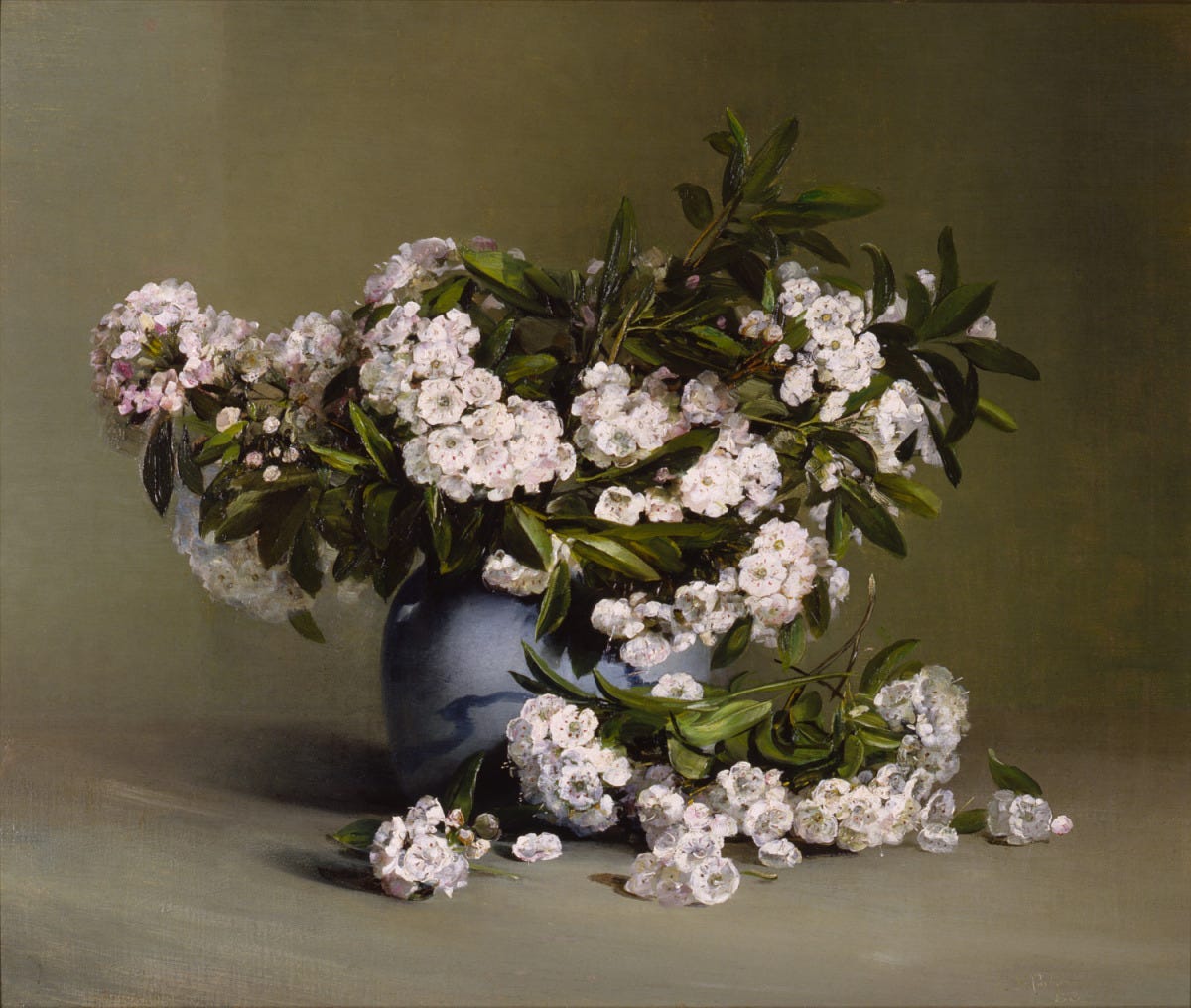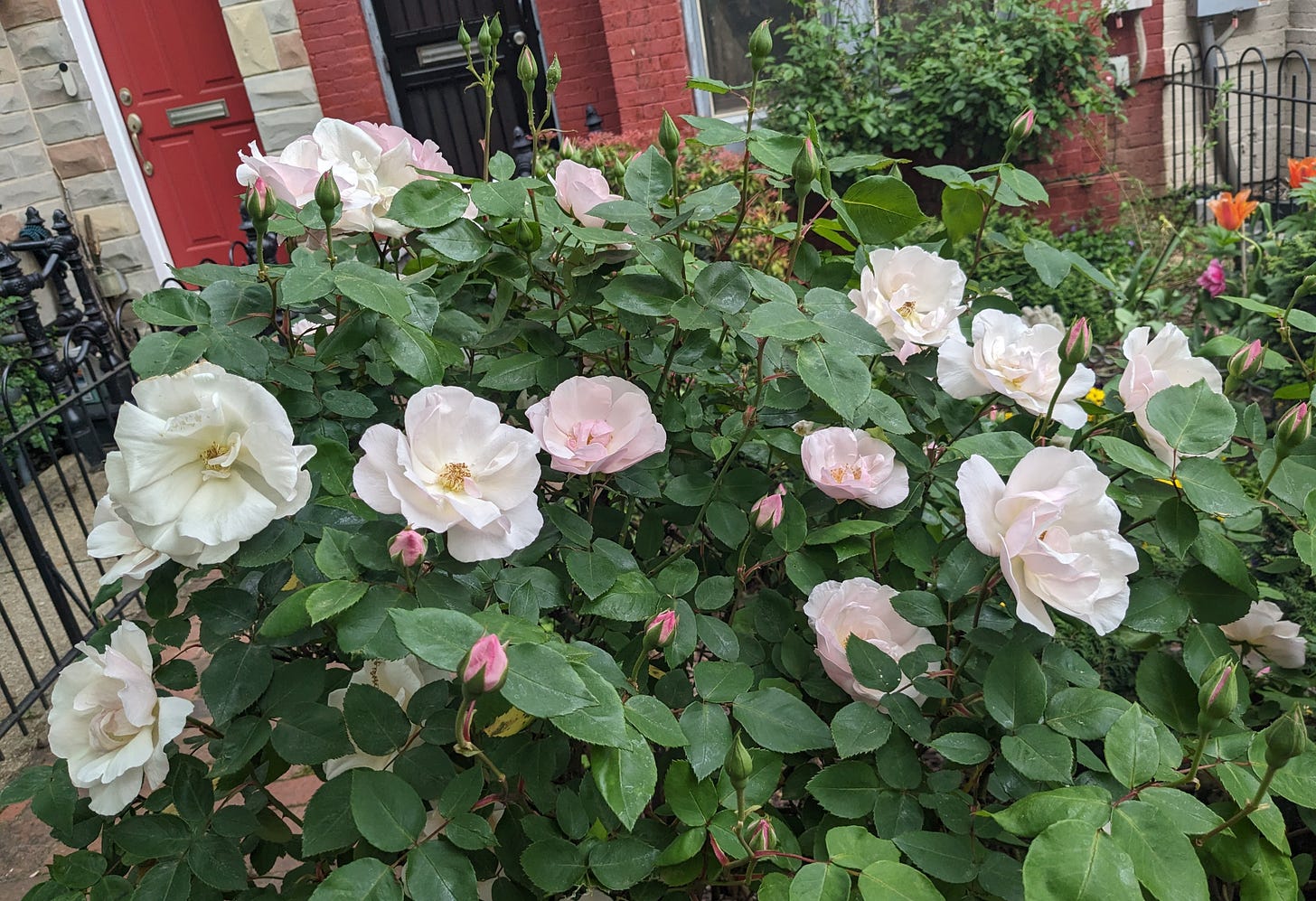A Decade, A Few Weeks, Only This Moment
Thinking about why artists train for years to paint something as ephemeral as flowers.
It’s amazing how quickly joy turns to greed.
My five kinds of roses put on their best shows yet this spring. Each plant produced what seemed to be a record number of blooms. In the front yard, the faintly pink-mostly white Souvenir de St. Anne’s roses gave off their unusual but beautiful sweet clove scent.
The Marie Daly rose by the front window once again defied its status as dwarf rose. It produced tall clusters of pink flowers.
The Charleston twilight rose decorated the fence in the backyard with dozens and dozens of butterscotch flowers.
The true name of this rose is crépuscule, marking a rare case where a French word is not prettier than its English translation, twilight.
In rebranding it, I also borrow a little magic from the rose’s heritage and add Charleston to the name. The crépuscule is a noisette, part of a variety of roses said to have been developed near that gorgeous South Carolina coastal city.
In my backyard, the neighbor of the Charleston twilight rose is Cornelia, a rose that forms full little bouquets when in bloom.
My three kinds of backyard roses even crossed paths briefly, which may not be the best gardening practice. The one circled in blue below is Mrs. Dudley Cross, a shrub rose I’ve trained to grow high as a climber. The rose circled in orange is the Charleston twilight rose, and the one in pink is Cornelia.
I tried to appreciate these robust displays of roses as they happened.
I tried not to think about how briefly these flowers would last. I tried not to obsess about how quickly they would fade and drop.
Tried to.
Did not succeed.
Stay in the moment, I reminded myself over and over, enjoy the flowers as they are now. But I cheated and took many photos. I took videos of the bumblebees feasting on the Cornelia roses, as shown below.
Fueled by Bustelo
These spring flowers were the payoff for many hours spent in 2011 and 2012 researching which roses could get through the humid summers of Washington, D.C. I tried about eight or nine different varieties of roses before settling on these five. And for more than a decade, I’ve tended to these five plants.
If you are a rose grower reading this, you may have recognized that a couple of the varieties I mentioned appear on the University of Texas EarthKind list. This is a great resource for people who want to find the hardiest roses. If you pick resilient roses, you can avoid using pesticides and harsh chemicals.
I try to use in my garden only products I would keep in my kitchen. That’s partly a selfish thought. I figure that anything I apply to the roses may find its way into the Chesapeake Bay and its tributaries, and then onto my plate in the form of locally caught crabs and rockfish.

So coffee grounds are the chief fertilizer for my roses. I joke that Café Bustelo fuels them. But it’s more often the remains of whatever medium roast coffee beans I found for a good price at the grocery store and then ground at home.
Years ago I heard John Sonnier, the head gardener at the British Embassy in Washington, speak. He avoids using chemical sprays on the famous roses at the embassy, preferring an organic approach to aid the environment. If memory serves, he also seemed to think the harsh chemicals didn’t do much even if you do use them. If you grow roses in the District of Columbia, it’s best to accept that they may look ragged in the summer.
I try each summer to fight off an invading fungus known as black spot by spraying mixes of diluted vinegar or diluted milk on the roses.
The fungus seems unbothered by my efforts.
Now it’s July. Black spot has left its mark on my roses and insects have chomped on many leaves, leaving some of them looking like tattered lace.
I accept that my rose plants will be ugly for most of the summer before— hopefully — they recover for another bloom in the fall.
Thinking about the roses made me consider how painters train for years to be able to capture flowers in bloom, of how hard they work to preserve that passing beauty.
I decided to look in the online collections of local museums for paintings of flowers to go with this essay. That led me to the work of Charles Ethan Porter, who made sacrifices to get the training he needed to be able to make spring come to life on canvas.

And researching Porter’s life led me to find surprisingly good advice from Mark Twain about my original dilemma, the difficulty of staying focused on the here and now.
“And you, yourselves, can’t ever fling a thought forward into the future without robbing the more valuable present,” Twain wrote in an 1881 letter.
For more on these topics, read these Medium essays:
A Realist in an Age of Imagination: Charles Ethan Porter
Mark Twain on Living in The Moment
Also, if you are interested in learning more about the writer born Samuel Clemens, check out the Mark Twain Project website.












I loved this so much and realized how different we are as gardners. I buy 2.99 cottage roses at Shoprite, throw them in the ground and hope. I'm currently looking out my window as I type at my flower-less sunflowers. Picture 4 foot high green stalks and you get the idea